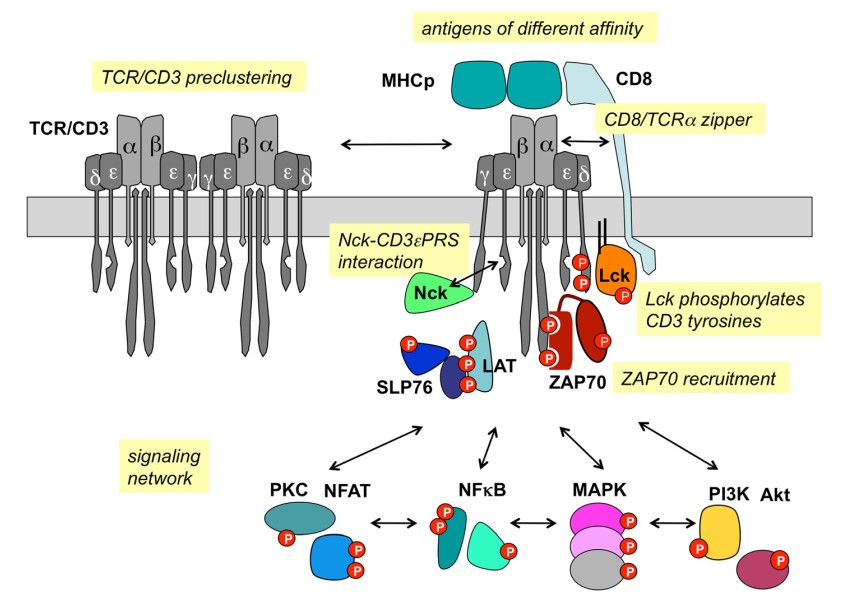Hi-Affi™ hPD-1/hCD3e Dual Humanized Mouse Model
The human cluster of differentiation 3e (hCD3e) binds to the T cell receptor (TCR) and participates in antigen recognition and intracellular signal transduction. Anti-hCD3e antibodies activate the effector T cells. The immune response in cancer patients could be improved by combining the anti-hCD3e antibody with the immune checkpoint inhibitor anti-hPD-1 antibody. Creative Biolabs has successfully established an optimized Hi-Affi™ “humanized” animal platform to offer specialty manipulated hPD-1/hCD3e dual humanized mice for our clients all over the world.
hPD-1/hCD3e Molecule
There are special proteins (receptors) on the surface of cancer cells. Under normal circumstances, T cells can adopt several mechanisms to identify cancer cells so that the cancer cells automatically lyse to maintain the balance of the body. However, cancer cells escape the attack from the host immune system by express a special protein (human programmed cell death ligand 1, (hPD-L1)) on the surface. hPD-L1 can bind to its receptor (human programmed cell death protein 1 (hPD-1)) on T cells to makes the T cells blind to spot cancer cells.
hCD3e, also known as hCD3ε, is a subunit of CD3 co-receptor. It is a type I membrane glycoprotein on the surface of T cells. The hCD3e molecule contains one immunoglobulin-like (Ig-like) domain and one ITAM domain. The hCD3e molecule forms a T cell receptor (TCR)-CD3 complex with CD3-γ, CD3-δ and CD3-ζ, and T cell receptor α/β and γ/δ heterodimers. This complex involves coupling antigen recognition and then facilitates multiple intracellular signal transduction pathways.
hPD-1/hCD3e Signal Pathway
The ligation of hPD-1 and hPD-L1 can inhibit the activation of cytotoxic T cells, which is one of the mechanisms adopted by cancer cells to avoid the killing of the immune cells. hCD3e molecule associates with T cell development. It is an important symbol on the surface of T cells and a T cell co-receptor, helping TCR to complete the intracellular transmission of the first signal. Because the two polymorphic subunits (TCRαβ or TCRγδ) in the TCR/CD3 complex mainly recognize antigens that bind to MHC molecules, and the intracellular region is very short, it is necessary to form TCR/CD3 complex in T cells. The complex can transmit the cell stimulation signal to the cell. After antigen stimulation, the conformational changes in the cytoplasmic tail of the CD3 polypeptide. Protein tyrosine kinases (PTKs) belonging to the Src family, such as LCK and FYN, phosphorylate tyrosine residues in the ITAMs of the CD3 complex to produce proteins with SH2 domains (such as zeta-related proteins, ZAP70). After ZAP70 binds to CD3, T cell activation adaptor LAT is phosphorylated, recruiting multiple adaptors and effector molecules (such as SLP76, PLCγ1, etc.) to form a LAT signaling complex. This mediates the activation of downstream signaling pathways, such as calmodulin, MAPK, and NF-κB signaling pathways.
 Fig.1 TCR/CD3 signaling pathway. (Louis-Dit-Sully, 2012)1,2
Fig.1 TCR/CD3 signaling pathway. (Louis-Dit-Sully, 2012)1,2
Development of hPD-1/hCD3e Dual Humanized Mice
Antibodies that use hCD3e as targets have also become another "gold mine" in the development of tumor-targeted therapeutic drugs. At present, anti-hCD3e antibodies have entered clinical trials. The combination of anti-hCD3e antibody and anti-hPD-1 antibody has become a new idea for cancer treatment in the future. With advanced technology, Creative Biolabs is a professional preclinical CRO company. We have assisted our global clients in their drug development using our Hi-Affi™ “humanized” animal models. If you are interested in these models, please feel free to contact us for more details.
Creative Biolabs also offers other various Humanized Mouse Models you may be interested in:
References
- Louis-Dit-Sully, C.; et al. Meeting report: signal transduction meets systems biology. Cell Commun Signal. 2012, 10(1): 11.
- under Open Access license CC BY 4.0, without modification.
For Research Use Only.
